Lasagna is a classic, rich, fulfilling meal. With so many layers, it can be hard to decipher how long this Italian dish needs to cook. An undercooked lasagna will have a cold center or worse: undercooked noodles. So, how long should you bake lasagna at 350?
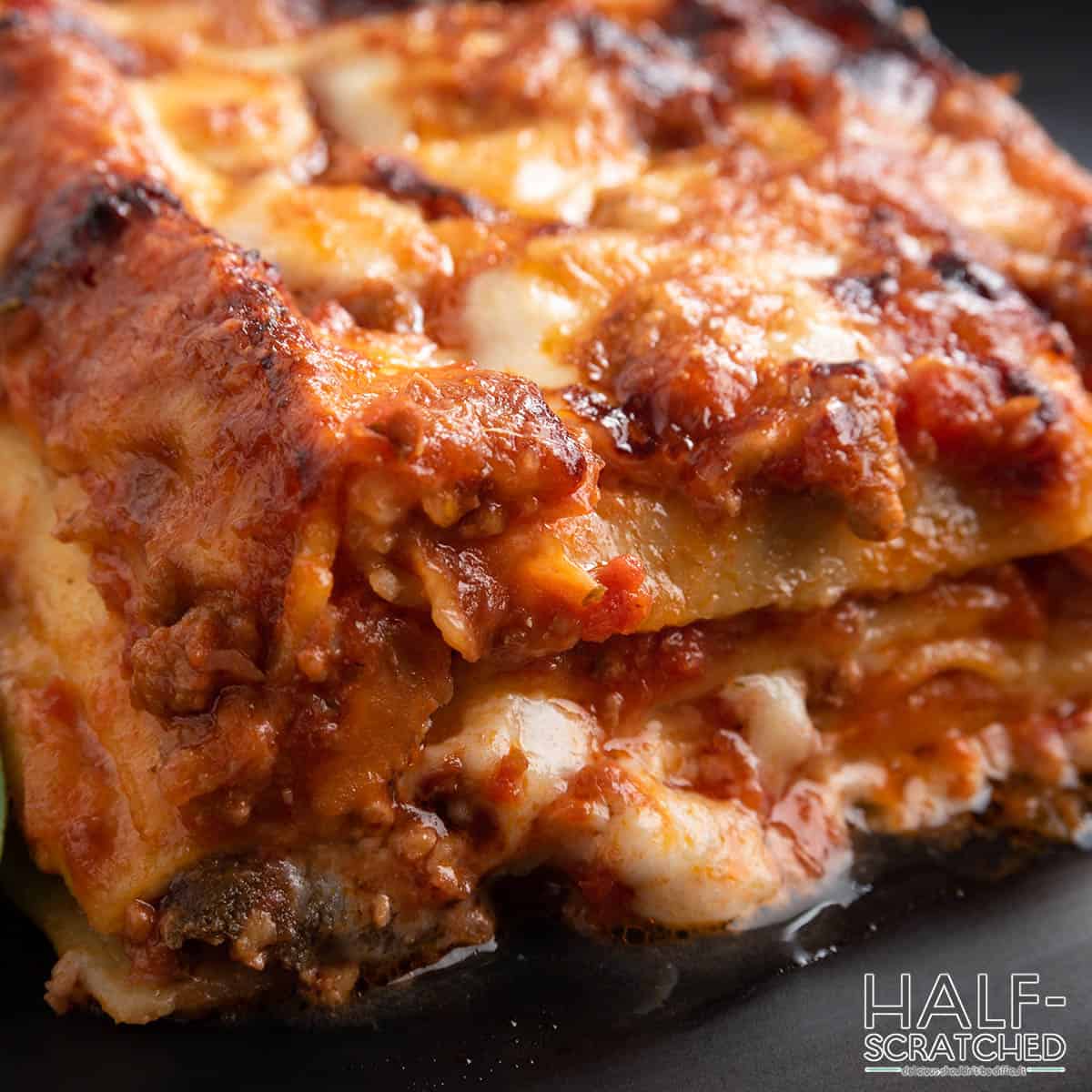
Lasagna should bake in the oven at 350 for 45-60 minutes if you’re using no-boil noodles. If your noodles are already cooked, that time is reduced to 30-45 minutes. How thick your lasagna is and how many layers you use will change the baking time.
Some of the hallmarks of a perfect, comforting lasagna are a crispy cheese topping and warm, melty layers. The inside shouldn’t be dry, but it shouldn’t slough out either.
These lasagna baking times assume that you’re making a 3-4 layer lasagna in a 9 x 13 pan.
Lasagna With No-Boil Noodles
Noodles that you don’t need to boil will save your prep time, but you’ll make up for it in how long you’ll have them in the oven. Lasagna made with no-boil noodles bakes in the oven for 45-60 minutes.
Lasagna With Cooked Noodles
Lasagna, where you’ve taken the time to cook the noodles beforehand, will need much less time in the oven. You should bake lasagna with cooked noodles for 30-45 minutes at 350.
Frozen Lasagna
What about a lasagna where you cut out most of the middleman? A store-bought or pre-frozen lasagna right from the freezer needs to be in the oven for at least 90 minutes at 350.
In Different Types of Pans
What type of lasagna you’re baking up isn’t the only thing you should consider when figuring out how long to bake lasagna at 350 in the oven. The vessel you’re baking the dish in will also change how long it will need to cook.
- Metal is a durable option for your lasagna dish, and it will shorten your cooking time by about 5-10 minutes. This is because metal heats up very quickly, especially aluminum.
- Glass pans also heat quickly, but they stay warm longer as well. Like with a metal pan, lasagna baked in a 350-degree oven will need about 5-10 minutes less.
- Ceramic is visually beautiful and excellent for cooking lasagna. However, it won’t shave any time off of your cooking.
There’s no ‘wrong’ dish for lasagna, but some have their advantages. Experiment with your equipment and oven to find what makes for your ideal baking setup.
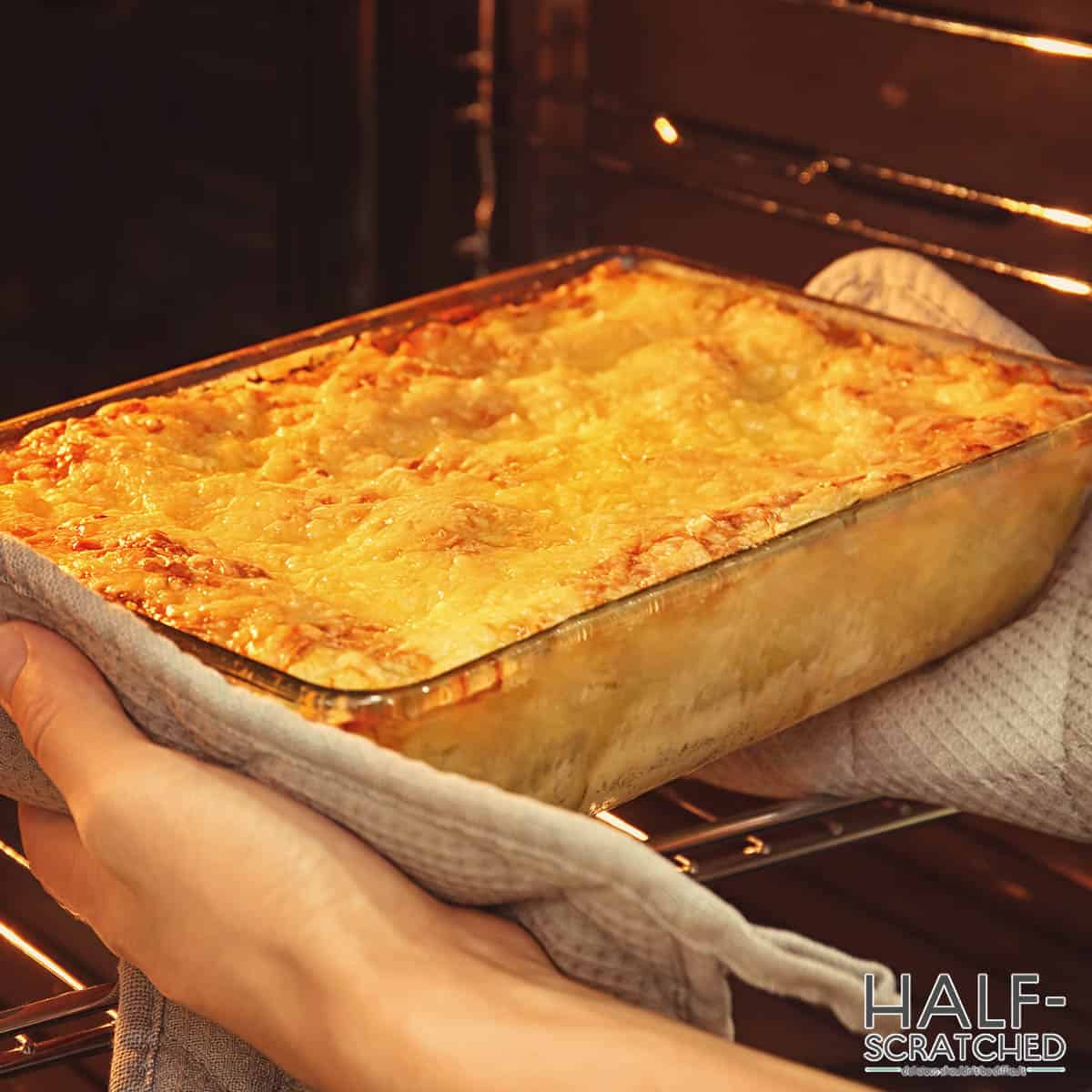
Should You Cover Lasagna in the Oven?
When baking your lasagna, whether or not you cover it is a matter of preference.
Usually, it will require some covering to help trap heat and steam in the dish. Other chefs prefer to skip this and allow their pasta to cook uncovered instead.
If you choose to cover, you may not need to do it for the entire baking time. If you like your cheese a little browned and crispy and bubbly, the lasagna should be covered all the way until the very last 10-15 minutes of baking time.
On the other hand, if you don’t want your cheese browned, just leave the foil on throughout the entire.
The lasagna will be delicious and fully cooked either way you choose to cover it.
Will a Thicker Lasagna Take Longer to Cook?
Thicker lasagna, especially one with a lot of dense layers, will take longer to bake in a 350-degree oven.
This is because the heat will need to penetrate through all of that meat and cheese to fully warm the center.
If your lasagna is made up of only a few thinner layers, you should reduce your expected cooking time by 10-15 minutes.
As always, your eyes will serve as the best gauge of when the meal is ready. If the sauce is bubbling, you can be sure that it is piping hot and ready to devour.
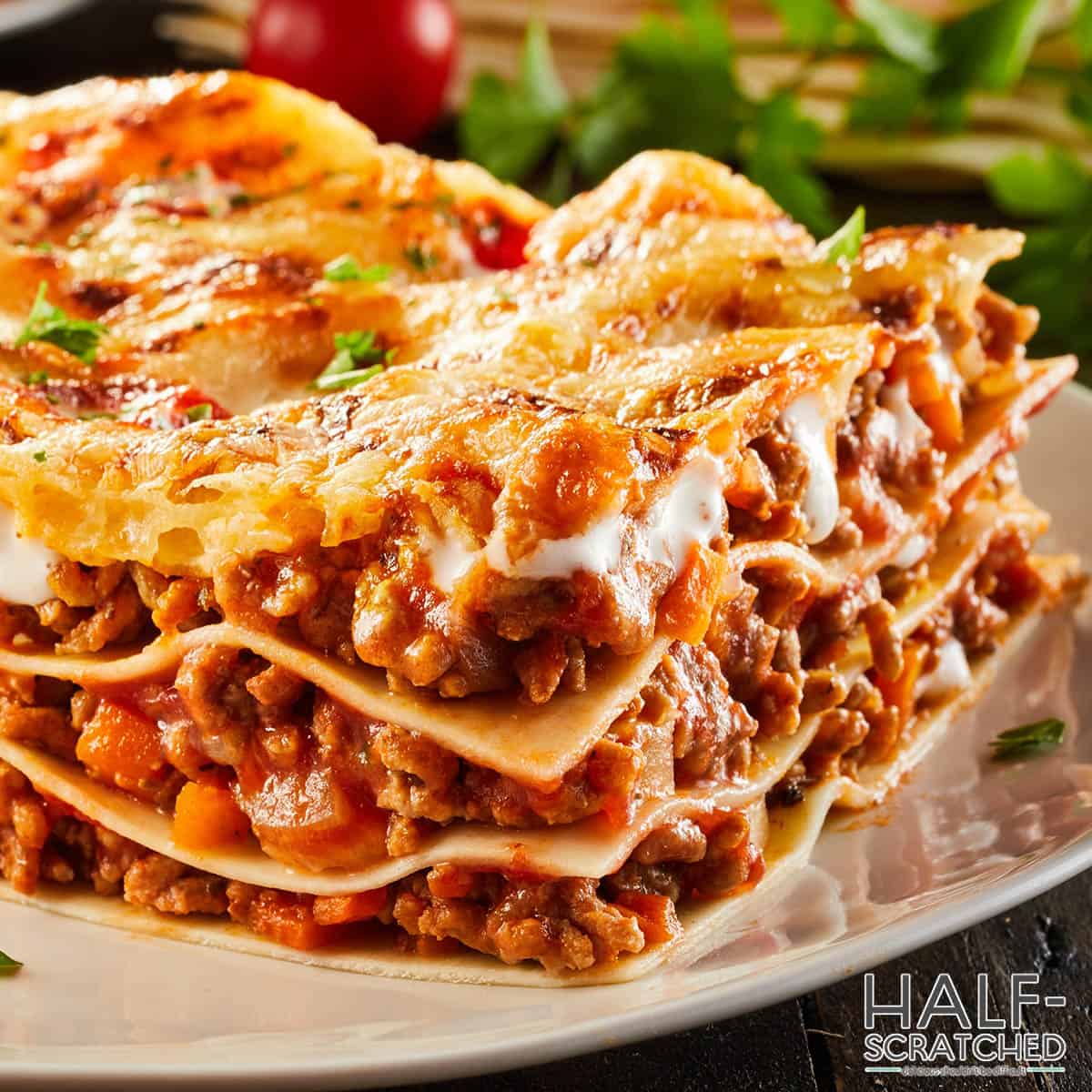
How Do You Know When Oven-Baked Lasagna Is Done?
How you’ll be able to tell when a lasagna is done comes down to how you cooked it.
Usually, if lasagna has meat, that meat will be cooked in a skillet before being sandwiched between the layers. The only thing that is going into a lasagna that needs to cook to completion is the soft mixture of eggs and cheese.
If you want to be extra sure that your lasagna is done, use a meat thermometer to gauge the internal temperature. When it hits between 165 and 175, the dish is sufficiently cooked.
If you want to make sure that your oven-ready noodles are done, you can use a toothpick inserted into the center. If the toothpick passes through without any interference, the noodles are nice and soft.
How Long Should You Let Lasagna Sit After Baking?
Wondering why your lasagna is so runny when you cut into it after baking? It might be because you neglected to let it rest for a few minutes.
Letting a lasagna come to rest after you take it out of the oven is a step you can’t skip when making this comforting, warm dish. Not only does it let the piping hot sauce and cheeses cool down, but it will get all of the elements to settle and set up.
If you allow your lasagna to sit out for at least 10 minutes after baking it, it will be much easier to slice through.
How to Reheat Lasagna in a 350-Degree Oven?
Looking to dig into your tasty leftovers the next day? Reheating your lasagna in a 350-degree oven is the best way to do it while maintaining flavors and textures.
Preheat the oven to 350 degrees. Place the leftover lasagna on a baking sheet - or use the dish it was baked in if it wasn’t taken out. Reheat your lasagna in the oven for 15-20 minutes. You’ll be able to tell that it’s done when you see the sauce and cheese bubbling.
Just like you do with freshly baked lasagna, let the reheated leftovers sit on the counter for a few minutes to settle before you tuck in.
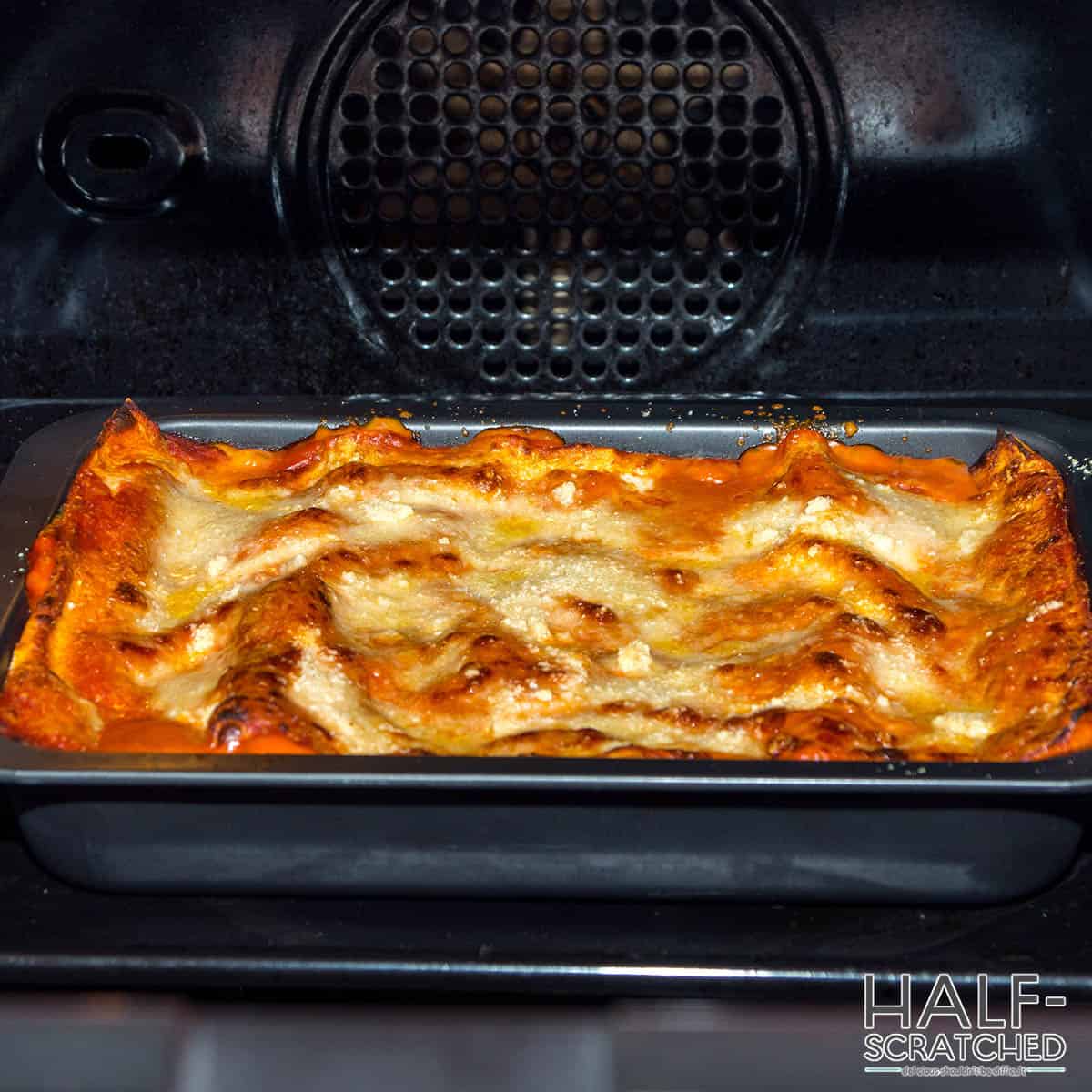
How Long Do You Bake Lasagna in an Air Fryer at 350
Lasagna can be cooked in an air fryer at 350, but with some stipulations. The most notable being the space available.
The largest air fryers have enough room in the basket for a 6-quart baking pan. Lasagna is usually a meal that’s meant to feed a lot of people, and an air fryer just isn’t conducive to large-scale cooking like that.
However, you can make smaller portions, such as an individual portion of lasagna, in an air fryer. If you’re baking it at 350, it only takes about 15 minutes to complete, assuming you’ve cooked the meat beforehand.
Can You Overcook Lasagna?
Just like anything else, you can definitely keep your lasagna in the oven a little too long. Overcooking lasagna is possible, albeit thankfully hard to do.
When lasagna is overcooked, the meat and cheese inside will get dry and somewhat chalky. You may also burn the cheese on top.
To avoid singed noodles, be sure to pay attention to the time as you’re letting that lasagna cook away. As a rule of thumb, start checking in on the dish about 30 minutes in, depending on your noodle type.
Overcooking The Noodles
The best lasagna is made with fresh, flat noodles, prepped right in your kitchen. Oven-ready is convenient, cutting down on what you’ll need to worry about on the stovetop, but pre-cooking your noodles have its benefits.
Be mindful, however, of how long you let the noodles boil in your pot. The noodles should be al dente when you drain them and create your layers.
When they’re stuffed in a dish with simmering sauces and bubbling cheese, the extra moisture that is released in the process will finish cooking your pasta. If you put noodles that have boiled too long into your lasagna, expect them to come out much mushier than you may like.
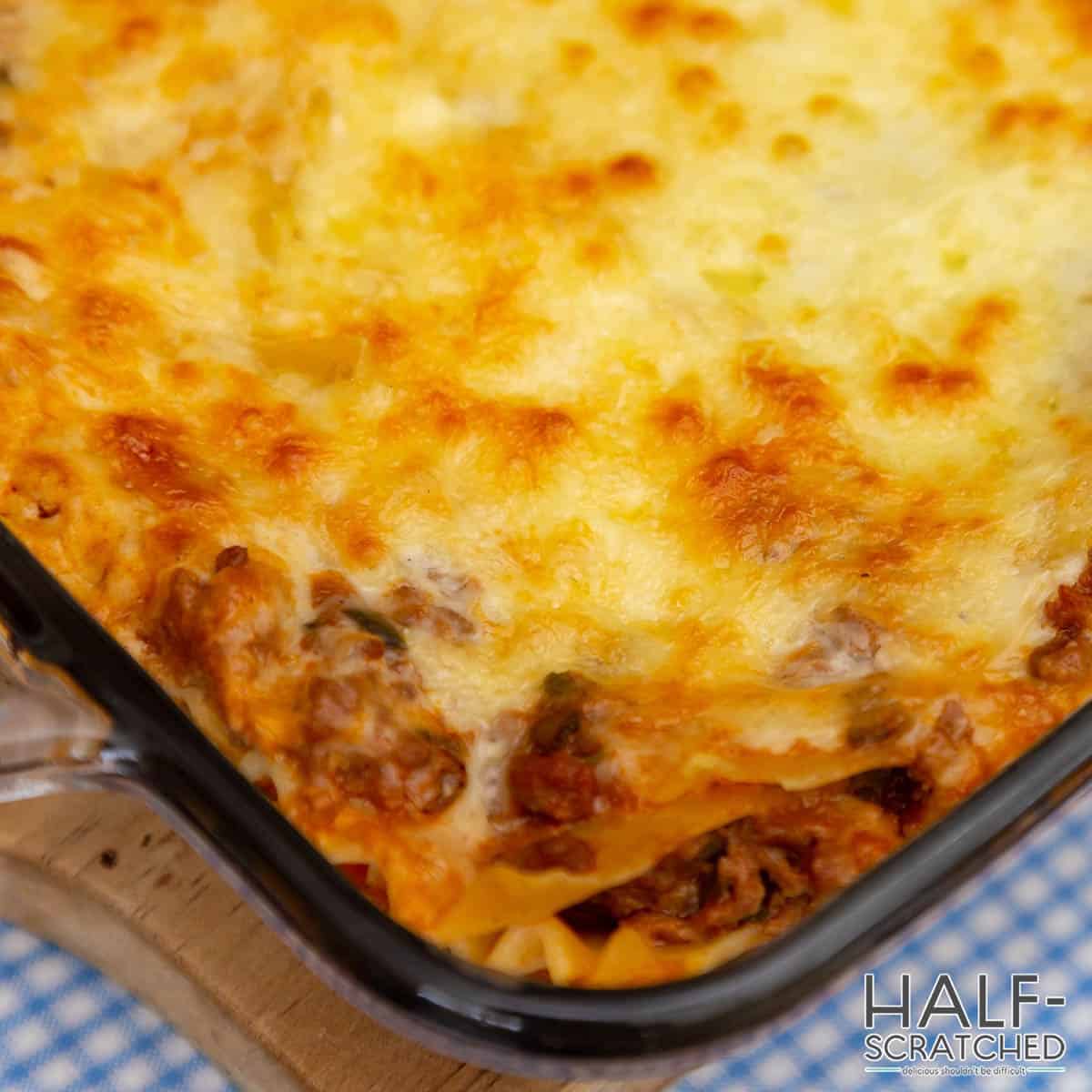
Questions and Answers
Lasagna is usually enough to feed a whole family for the night. However, leftovers lingering after the plates have been cleared away are bound to happen.
To store a lasagna in the fridge, place it in a dish, or use the vessel you cooked it in, after you have given it some time to naturally cool down. When covering the lasagna, make sure you press your foil as close to the surface as possible. This will keep extra air from getting to your meal.
Lasagna can stay in the fridge for 2-3 days.
You can definitely freeze and reheat oven-baked lasagna.
When you’re ready to freeze it, wrap the lasagna in a tight layer of plastic after it has cooled down. Then, wrap that in foil.
Lasagna will keep in the freezer for about three months. After that, it will lose much of its flavor and texture.
All you’ll need to do when it’s dinner time again is unwrap the lasagna and place it in the oven. Be sure to remove the plastic first, of course.
Delicious, Basic Lasagna Recipe
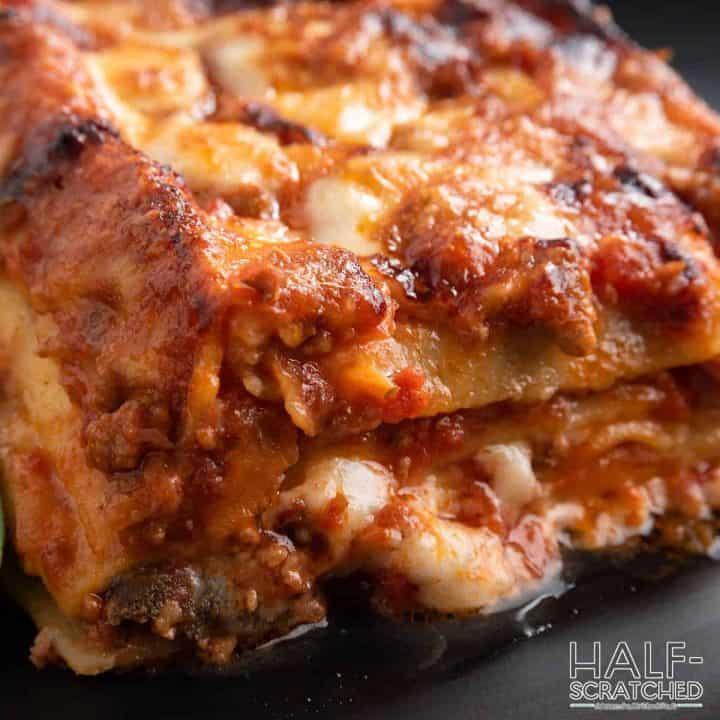
How Long to Bake Lasagna at 350 F
Some of the hallmarks of a perfect, comforting lasagna are a crispy cheese topping and warm, melty layers. Learn exactly how to make perfect lasagne.
Ingredients
- 2 cups of your favorite pasta sauce, homemade or store-bought
- 1 pound of ground beef or turkey
- 1 can of tomato paste.
- 2 teaspoons of dried basil
- 2 teaspoons of oregano (you can also use Italian seasoning)
- 2 teaspoons of onion powder
- 1 tablespoon of parsley
- 2 cups of 4% small curd cottage cheese or ricotta cheese.
- 1 large egg
- 8 oven-ready lasagna noodles
- 4 cups of shredded mozzarella cheese
- 1 cup parmesan cheese
Instructions
- Preheat your oven to 350
- Brown your ground beef in a skillet, seasoning as desired.
- Add the sauce to your beef and simmer for ten minutes.
- While the sauce is simmering, combine egg, ricotta, half of the mozzarella, parmesan, parsley, salt, and pepper in a large bowl. Combine.
- Begin to line your baking sheet. Start by spreading a layer of your meat and sauce mixture over the bottom.
- Lay 4 lasagna noodles over the meat mixture
- Spread ? of the cheese and egg mixture over the noodles. If you’re adding vegetables, here would be the place to do so.
- Add another cup of the sauce and meat over the cheese. Repeat steps 5-7 until all of the ingredients have been used or until the container cannot hold anymore.
- Top the layers with the last of the mozzarella cheese.
- Cover the dish with foil and bake for 60 minutes or until the lasagna is fully cooked.
- If you want your dish to have a crusty top, remove the foil layer within the last 10 minutes of cooking. If you don’t want the cheese to crisp up, leave the foil on.
Nutrition Information:
Yield: 4 Serving Size: 1Amount Per Serving:Calories: 1156Total Fat: 57gSaturated Fat: 26gTrans Fat: 2gUnsaturated Fat: 22gCholesterol: 284mgSodium: 1961mgCarbohydrates: 72gFiber: 7gSugar: 19gProtein: 88g
Customize Your Lasagna
This is just a basic recipe for a standard dish, as you would see in a grocery store. Lasagna is a fantastic canvas that you can dress up or down to your liking.
If you don’t like meat or just want a version of this dish that is more nutritionally sound, vegetables like eggplant, zucchini, and spinach make delicious fillings.
Alfredo or pink sauce lovers can also mix up this Italian classic by swapping the marinara meat sauce with their personal favorites.
The meats are also up for debate. Ground beef and Italian sausage are the standard but don’t be afraid to get creative. Chicken, turkey, and pork will be right at home, nestled between those cheesy layers.
No matter how you spin it, bear in mind that you may be looking at a different baking time depending on your preferred configuration. Thicker lasagnas are going to bake in a 350-degree oven for longer than a slim, thin one.


Leave a Reply